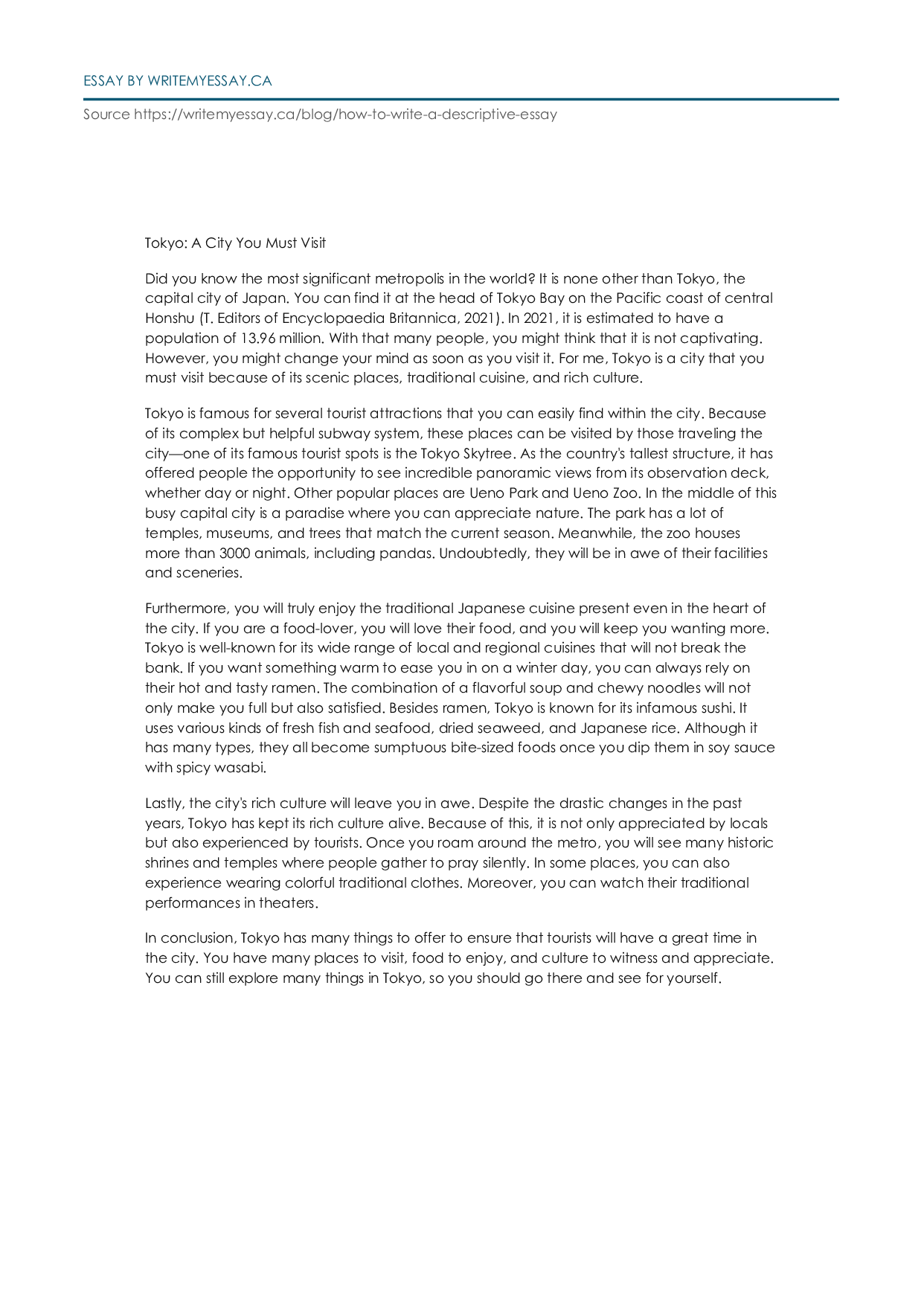
How to write a Descriptive Essay

Table of Contents
- What Is A Descriptive Essay
- Why It Is Important To Know How To Write A Descriptive Essay
- Descriptive Essay Structure & Format
- How To Start A Descriptive Essay
- How To Write Body Paragraphs
- How To Write a Conclusion For A Descriptive Essay
- Tips For A Great Descriptive Essay
- Difference Between A Description And A Descriptive Essay
- Short Example Of A Descriptive Essay
As humans, we are given five senses to use in our daily lives. These abilities aid us in navigating through simple to complex situations. From brushing our teeth to buying necessities, we rely significantly on them. However, there are just some moments in our life when we cannot describe things the way our senses perceive them. Moreover, this becomes a big dilemma in making a descriptive essay. Nowadays, you can always pay someone to write an essay the way you intend. However, if you wish to learn how to do it yourself, this article can help you gain knowledge and learn some valuable tips.
○ What Is a Descriptive Essay?
From the name itself, a descriptive essay describes someone or something. It can be about a person, object, place, event, experience, situation, or emotion. As a writer, your goal is to (figuratively) paint an image of the subject by filling it with details.
This genre encourages you to recount a particular experience that is memorable to you. It should stimulate your readers to use their five senses of sight, hearing, taste, smell, and touch. Moreover, it would help if you appealed to your readers’ minds through vivid narration or description using adjectives and figurative language. In the end, they should perceive the experience the way you did while reading.
Besides detailed descriptions, you should communicate your learning points so that the readers can learn from the experience, too. You can also talk about how it impacted your life, positively or not. Through your work, your readers should gain something that they will never forget.
The best way to approach writing a descriptive essay is to think about it like painting a picture with words. The job of the writer is to make the subject come alive with all the intricate details. That’s why sensory details and imagery come to the fore in the description. In addition to this, literary devices like metaphors and similes play a major role in connecting readers with the focal point of the essay. Perhaps the value of words and phrases and their deeper meanings are more important in this type of essay than ever!
● Why It Is Important to Know How to Write a Descriptive Essay
Every school activity has a purpose. Nevertheless, sometimes, your teachers might forget to relate their lessons with their corresponding real-life applications. Whatever reason they might have for not imparting them, it is not enough for you to know the facts and theories alone. Understanding the relevance and application of the subject is much more significant for more meaningful learning.
Like any other writing task, making a descriptive essay hones your capabilities as a student and a soon-to-be professional. By doing this, you also improve your writing skills, focusing on broadening your vocabulary to use the correct adjectives. Because this genre heavily relies on descriptive words, you must learn new words to be more precise. Moreover, you can use this as an avenue to share your experiences and learnings so that others can reflect and learn from them as well.
● Descriptive Essay Structure & Format
If you are still asking yourself, “What is descriptive writing?” at this point, you need to read this section. In this part, you will read specific guidelines and tips that you can use while drafting. The information you will see here will answer your questions.
○ How to Write an Outline
Many students tend to start drafting without outlining. They think that doing this saves them time. Nevertheless, if they do not, they risk having an unorganized output. Because they do not have a reference, they will keep on rambling random insights. After drafting, they will realize how cluttered the sentences and paragraphs are. So, it is much more efficient to start making a descriptive essay outline first. It saves you time and energy in the long run.
Like other kinds of essays, you can use the standard outline that most educators recommend. It is easy to follow and will make your points and supporting details more organized. Below is an example that you can refer to while you make your own.
Topic: Tokyo: A City You Must Visit
Introduction:
- Start with a “hook” about Tokyo to get your readers’ attention
- Give some background information or history about the place
- Thesis statement with at least three main points
I. First reason to support your thesis: Places to visit
- Topic sentence expounding your first main point
- Two or more supporting details
II. Second reason to support your thesis: Food to enjoy
- Topic sentence expounding your second main point
- Two or more supporting details
III. Third reason to support your thesis: Culture to witness and appreciate
- Topic sentence expounding your third main point
- Two or more supporting details
Conclusion:
- Summary of main points or reasons
- Restate the thesis statement
- Learning points or recommendations to the readers (if applicable)
○ How to Start a Descriptive Essay
Because many people have short attention spans, it will be challenging for you to capture their interest. Therefore, introductions are crucial in any academic paper. Right from the beginning, you must already spark your readers’ attention and curiosity. It will lead them to continue reading and eventually finish the output. If you ignore your introduction, they will not be excited. Soon, they will stop reading along the way.
You have several options when making an introduction. If you want to talk about a person, you can start with an interesting fact or event in his or her life. Alternatively, you can share your anecdote related to him or her. If you choose to write about a place, it would be best, to begin with, a trivia, rhetorical question, or popular trends.
Afterward, you can give more background information or history about your topic. It will provide the readers with what they need to know while reading. Lastly, introduce your thesis statement with three main points, which you must prove in the body.
● How to Write Body Paragraphs
An excellent descriptive essay is organized, detailed, and engaging. Moreover, you have to ensure that your body paragraphs prove your thesis statement in the end. To do this, you need to refer to your claim and divide them into three main points. You must put one main point per body paragraph to ensure that all the insights and supporting details are organized.
Once you have done these, you can start each body paragraph with a topic sentence. It should reflect the main point dedicated to that part. Afterward, substantiate it with supporting details through examples, evidence, or description. Because you are writing a descriptive essay, it is imperative that you fill the paragraphs with adjectives or describing words. It would be best if you used sensory language for the readers to paint a clear picture of what you are detailing.
● How to Write a Conclusion for a Descriptive Essay
Despite being the last part, conclusions are still important in any writing task. Through this, your readers will remember what they have read and later evaluate whether you have made a point. Like how endings are crucial in movies, you should also make sure that your conclusion is memorable. This way, you can impart knowledge and impact your readers.
To do the conclusion, you can rephrase your thesis statement and summarize your main points. Finally, you can end it with your learning points from experience or give your readers recommendations. By doing this, they can take away something from your work that they can apply in their lives.
● Tips for a Great Descriptive Essay
Even though the information given above can help you already, you might still need some tips to work more efficiently. Below are eight tips that you can follow to make an excellent descriptive essay.
- Choose a topic that interests you.
- Schedule your brainstorming to editing phases.
- Reserve the third body paragraph for the most critical point.
- Search for appropriate adjectives to make a descriptive paragraph.
- Choose vivid and sensory language.
- Maximize your outline to keep the flow of ideas organized.
- Proofread and edit your work.
- Let someone read your paper and ask if they could create an image of the subject based on your descriptions.
● Difference Between a Description and a Descriptive Essay
What is a description in writing? How is it different from a descriptive essay? These are three differences between the two.
- Descriptions are spoken or written representations of a person, object, or event. Meanwhile, a descriptive essay is an organized output using descriptions as a way of telling experiences.
- The former is a rhetorical strategy that uses sensory details to portray a person, place, or object in literary terms. On the other hand, the latter is an essay that gives vivid and detailed descriptions of someone or something. It has the same structure as any other type of essay.
- The former is the element that writers use to make the latter.
● Short Example of a Descriptive Essay
It is easier to have an idea of what you should do if you have examples as references. Below is an example that you can read and analyze. However, you can also search for writing description examples online for more sources.
Tokyo: A City You Must Visit
Did you know the most significant metropolis in the world? It is none other than Tokyo, the capital city of Japan. You can find it at the head of Tokyo Bay on the Pacific coast of central Honshu (T. Editors of Encyclopaedia Britannica, 2021). In 2021, it is estimated to have a population of 13.96 million. With that many people, you might think that it is not captivating. However, you might change your mind as soon as you visit it. For me, Tokyo is a city that you must visit because of its scenic places, traditional cuisine, and rich culture.
Tokyo is famous for several tourist attractions that you can easily find within the city. Because of its complex but helpful subway system, these places can be visited by those traveling the city—one of its famous tourist spots is the Tokyo Skytree. As the country’s tallest structure, it has offered people the opportunity to see incredible panoramic views from its observation deck, whether day or night. Other popular places are Ueno Park and Ueno Zoo. In the middle of this busy capital city is a paradise where you can appreciate nature. The park has a lot of temples, museums, and trees that match the current season. Meanwhile, the zoo houses more than 3000 animals, including pandas. Undoubtedly, they will be in awe of their facilities and scenery.
Furthermore, you will truly enjoy the traditional Japanese cuisine present even in the heart of the city. If you are a food-lover, you will love their food, and you will keep you wanting more. Tokyo is well-known for its wide range of local and regional cuisines that will not break the bank. If you want something warm to ease you in on a winter day, you can always rely on their hot and tasty ramen. The combination of a flavorful soup and chewy noodles will not only make you full but also satisfied. Besides ramen, Tokyo is known for its infamous sushi. It uses various kinds of fresh fish and seafood, dried seaweed, and Japanese rice. Although it has many types, they all become sumptuous bite-sized foods once you dip them in soy sauce with spicy wasabi.
Lastly, the city’s rich culture will leave you in awe. Despite the drastic changes in the past years, Tokyo has kept its rich culture alive. Because of this, it is not only appreciated by locals but also experienced by tourists. Once you roam around the metro, you will see many historic shrines and temples where people gather to pray silently. In some places, you can also experience wearing colorful traditional clothes. Moreover, you can watch their traditional performances in theaters.
In conclusion, Tokyo has many things to offer to ensure that tourists will have a great time in the city. You have many places to visit, food to enjoy, and culture to witness and appreciate. You can still explore many things in Tokyo, so you should go there and see for yourself.
● Q&A
If you still need clarification about this writing task, you can read some commonly asked questions and their corresponding answers below.
○ How do you start a descriptive essay?
As mentioned previously, there are many ways you can start. You can use a rhetorical question, interesting fact, recent statistics, or personal anecdote. Whatever you use should be relevant to your topic. This is called a hook, a literary device to create an instant connection with readers. Once you set up a solid hook, it is best to provide some background information on the main topic to help readers understand what the main title is about. In the closing lines of the introduction, place your thesis statement to get a well-rounded effect.
○ What is the structure of a descriptive essay?
A descriptive essay format follows the standard outline, including the introduction, body paragraphs, and conclusion. It would be best to dedicate one paragraph to each main point in the body paragraphs. Many students think that they have ample space in this section, they can drag a point at great lengths. In reality, they should make every word count, whether it is the introduction or a conclusion.
○ What is an example of descriptive writing?
The example above is a descriptive essay. If you need a few examples, you can check out the pre-written essays offered by WriteMyEssay.ca. They have a vast collection of works that you can instantly download and use as references.
{“@context”:”https://schema.org”,”@type”:”FAQPage”,”mainEntity”:[{“@type”:”Question”,”name”:”How do you start a descriptive essay?”,”acceptedAnswer”:[{“@type”:”Answer”,”text”:”As mentioned previously, there are many ways you can start. You can use a rhetorical question, interesting fact, recent statistics, or personal anecdote. Whatever you use should be relevant to your topic. “}]},{“@type”:”Question”,”name”:”What is the structure of a descriptive essay?”,”acceptedAnswer”:[{“@type”:”Answer”,”text”:”A descriptive essay format follows the standard outline, including the introduction, body paragraphs, and conclusion. It would be best to dedicate one paragraph to each main point.”}]},{“@type”:”Question”,”name”:”What is an example of descriptive writing?”,”acceptedAnswer”:[{“@type”:”Answer”,”text”:”\nThe example above is a descriptive essay. If you need a few examples, you can check out the pre-written essays offered by WriteMyEssay.ca. They have a vast collection of works that you can instantly download and use as references.\n”}]}]}





